The Northern Weekly Salvo
Incorporating Slaithwaite Review of Books, Weekly Notices, Sectional Appendices, Tunnel Gazers’ Gazette etc. Descendant of Teddy Ashton’s Northern Weekly and Th’Bowtun Loominary un Tum Fowt Telegraph
Published at 109 Harpers Lane Bolton BL1 6HU email: paul.salveson@myphone.coop
Publications website: www.lancashireloominary.co.uk
No. 309 December 14th 2022 Christmas Extra
Salveson’s half-nakedly political digest of railways, tripe and secessionist nonsense from Up North. Sometimes weekly, usually not; definitely Northern.
It’s that time of year
Welcome to the Christmas Salvo for 2022. This edition has some weighty stuff on things like Gordon Brown’s report on devolution, and a portrait of an extra-ordinary Lancashire radical, Solomon Partington (first published in the Bolton News). There’s also a brand-new Christmas ghost story. You’d probably got sick of reading Who Signed the Book? every year. This tale is set on the same bit of railway, between Bolton
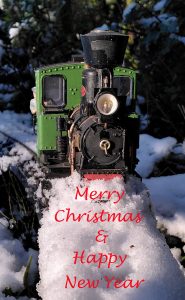
and Blackburn. Hope you enjoy it. I’ll probably do an end of year edition after Christmas, trying to avoid saying a lot of boring things about what is happened in 2022 and regurgitating stuff I’ve already published. We’re well and truly into the festive season now and here in Bolton we’ve had plenty of snow; it still looks very white out there. I love it, but I find myself having to be extra careful walking on the slippery surfaces. Signs of old age ….But anyway, stop it. Have a lovely Christmas! I hope to do a New Year Crank Quiz for issue 310. If you want any last minute Christmas presents I’ve got some of my books going at bargain prices, including Settle-Carlisle Railway (just had a new consignment from the publisher).
Railways in melt down? Fresh thinking required.
The general view of the railways at the moment ranges between ‘awful’ and ‘disastrous’. The combination of industrial action and ongoing problems related to Covid have resulted in cancellations and poor reliability, even when trains are supposed to be running. Interestingly, agreement has been reached on some parts of the network which are not controlled by the Westminster government, which says a lot. It does look increasingly like there is a settlement to be had but the main obstacle is no. 10. When interviewed, Rail Minister Huw Merriman
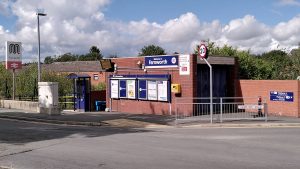
says that devolved governments who’ve settled with RMT ducked the issue of workplace reform. Maybe he has a point but throwing wholesale ticket office closures and driver-only operation into the bag was never going to result in an agreement. Some reform is needed, there’s no question about that – around Sunday working particularly and more flexible use of Network Rail maintenance teams. However, blanket closure of ticket offices would be hugely unpopular with the travelling public, even if there are no compulsory redundancies.
There has been talk of ‘re-purposing’ ticket offices but there’s no clarity on what that means. You can’t compare regional rail services with London Underground where ticket offices have disappeared but a staffed presence remains on platforms. It’s not the same kind of railway. People welcome a staffed presence in a ticket office for all sorts of things – not just getting a ticket but general enquiries and a sense of security, even if the person isn’t on the platform. How do we make bettr use of that precious resource?
The Rail Reform Group recently held a well-attended seminar on the future of stations in the appropriate surroundings of the Platform 5 Gallery on Bolton station. Dr Nicola Forsdyke and Alex Warner gave stimulating presentations on ways forward which involve keeping a staffed presence at all or most stations (maybe even some new ones) but doing different things. The debate goes back a long way and it was pointed out that even in BR days more creative use of ticket offices was debated. A full report of the seminar will be available shortly.
Meanwhile, is it time to re-visit local operation of secondary railways? ‘Microfranchising’ was the dog that never barked, but as the railways enter a new era of possible cuts, different ways of operating and managing the more peripheral parts of the network should be explored once more. What a shame Adrian Shooter isn’t around to help with the vision.
Brown’s Report fails to inspire
Labour’s new report A New Britain: Renewing our Democracy and Rebuilding our Economy has had a mixed reception. The report was the work of the ‘Commission on the UK’s Future’ chaired by Gordon Brown. The SNP described the proposals for Scotland as ‘underwhelming’ and I must say that was my reaction to its ideas for England. It’s a weighty piece of work, without a doubt, running to over 150 pages. It recognises that there is a big problem with our centralised United Kingdom and it’s time for change: “The UK is at a constitutional moment, and needs change comparable to the important shifts in power in the 19th and 20th centuries that widened the franchise,
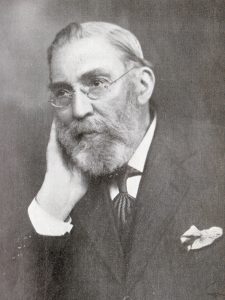
reformed Parliament or, more recently, introduced devolution. Our economy is faltering. Our democracy has lost the trust of its people, who have repeatedly voted for change. 17.4m people voted for Brexit in 2016 and 1.6m in Scotland voted to leave the UK in 2014. Britain urgently needs a new government.”
I think we can all agree on that, and the follow-on which states that “if we are to transform our country, we must change not just who governs us but how we are governed.” Yet this is where the report is weak, ducking out of the chance to transform the structures of UK governance and really energise the regions and nations of the UK. That’s not to say that there’s nothing good about the report – that would be a ridiculous response. Where it is perhaps clearest is on House of Lords reform – proposing to replace it with an elected second chamber – an ‘Assembly of the Regions and Nations’. Yet ironically, while the House of Lords is a very easy target, it probably isn’t the biggest issue facing constitutional reform. As the report says, for all its lack of democratic credibility, the Lords does have a lot of expertise which is put to good use in scrutinising and challenging Governments of the day.
The report scores several good ‘hits’, highlighting the problems of over-centralisation: “Brexit has not delivered the control people were promised. Britain hasn’t taken back control – Westminster and Whitehall have. And our over-centralised system has shown itself to be open to abuse – the conventions of our unwritten constitution ignored; conflicts of interest allowed to fester; the use of patronage intensified, and ethical standards – and advisers on ethics – swept aside, ignored by a conservative political class that has tried to act without constraint. Meanwhile, decisions of vital importance to communities – including the allocation of funds under Levelling Up – are made for increasingly naked party political reasons, further undermining trust. All of this makes the case for a radical devolution of power to locally elected and locally accountable representatives best placed to identify the needs
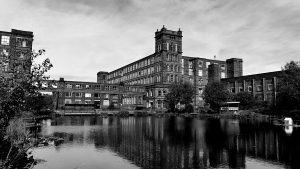
and opportunities in their own areas, and to unleash the potential that exists everywhere throughout the country. Our aim must be to put power and resources in the hands of communities, towns, cities, regions and nations, to make their own decisions about what will work best for them.”
Yes, absolutely, but the report fails to recognise that the levers at our disposal, particularly in England, are woefully inadequate. The mishmash of poorly-funded local councils, a mix of unitary and two-tier authorities, with ‘combined authorities’ in metropolitan areas, is a very poor structure indeed to be given significant new powers. Yet we’re told that “across England, we recommend that every town and city is given the powers needed to draw together their own economic and social plan and take more control of their economic future. In particular we believe that by empowering Mayors, Combined Authorities and local government in new economic partnerships, we can create and advance a supportive environment for the dynamic new clusters in the digital, medical, environmental and creative industries in a new pro-growth strategy, and make every part of our country more prosperous.”
Really? I don’t think so, and the report’s authors missed a great opportunity to democratise the combined authorities by in effect creating new regional forms of government that would be directly elected. Instead, we’re told that “We cannot turn the clock back to recreate Regional Development Agencies, or still less to impose a system of regional government from the centre on the different parts of England. This gap must be filled by growth from the bottom up.”
Actually we could. It’s what governments do. What we are likely to get is confusing mixture of mostly unelected local bodies or ‘partnerships’ with increasing powers given to mayoral combined authorities which have just one person being subject to direct election. There is a massive democratic deficit with the combined authorities which has excited little comment amongst the political classes – either because they are
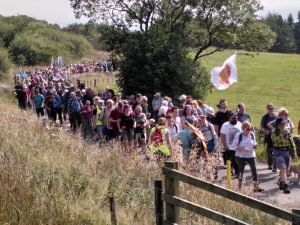
outside of London so of little interest, or there are too many vested interests involved in keeping them as they are, overseen by leaders of the relevant constituent authorities. The report does nothing to address this and overall represents a huge missed opportunity to create a ‘New Britain’. There is a model out there already with the directly-elected (by PR) governments in Cardiff, Belfast and Edinburgh. Why not the same for the English regions?
(first published in Chartist magazine)
The report is here: https://labour.org.uk/wp-content/uploads/2022/12/Commission-on-the-UKs-Future.pdf
Christmas Ghost Story: The First Aid Phantom of Wayoh Sidings
My grandchildren are always meithering me for a ‘ghost story’ this time of year. Well here’s one about a benevolent ghost, or boggart, which featured in something that happened to me a long time ago when I was a young relief signalman in Bolton.
It was December 1966, not long after I’d been promoted from my first signalbox at Bullfield West to a ‘relief’ job, with more money. It involved covering rest days, holidays and sickness at several boxes in the Bolton area, mostly within a mile or so of the station. A couple were more remote; the furthest and most difficult one to reach was Wayoh Sidings, up on the moors between Bolton and Blackburn. The 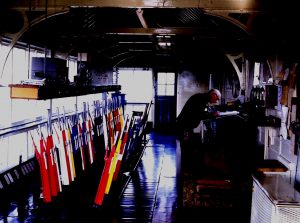 only way you could reach it was by walking up the line from Entwistle, just over a mile. There was no road access and the other relief men didn’t like it – they couldn’t get there by car. I was young and fit back then and would either walk or even cycle up the path along the line, keeping an eye out for passing trains. If it was wet, most drivers – if you asked them nicely – would drop you off outside the box.
only way you could reach it was by walking up the line from Entwistle, just over a mile. There was no road access and the other relief men didn’t like it – they couldn’t get there by car. I was young and fit back then and would either walk or even cycle up the path along the line, keeping an eye out for passing trains. If it was wet, most drivers – if you asked them nicely – would drop you off outside the box.
Wayoh Sidings was at the summit of the line, the end of a long gruelling climb in both directions. It was a lonely place, with the nearest houses half a mile away near the old quarry on the Roman Road. Beyond the box, going north, the line plunged through a deep cutting and then into the two-mile long Whittlestone Tunnel. In steam days most of the freights would be ‘banked’ by a loco coming up behind the train, from either Bolton or Blackburn. When the train reached Wayoh Sidings the assisting engine would shut off steam and come to a stop by the signalbox, with the signalman changing the points to allow it to 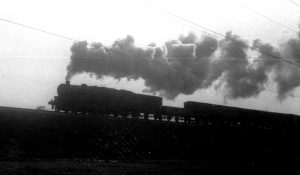 drift back to base. If there was nothing else about, the driver and fireman would park their engine outside and come up for a brew.
drift back to base. If there was nothing else about, the driver and fireman would park their engine outside and come up for a brew.
That was about the only company you’d get, apart from the occasional platelayer. Harold Hodgkiss was the regular man who walked his length every week and would call in to ‘camp’ over a brew of tea.
I was rostered to cover the night turn at Wayoh in the week before Christmas, relieving the regular signalman, Frank Hatton, at 10.00pm. Once you’d got there it was an easy job, just an empty stock for Newton Heath depot about midnight, the Colne ‘papers’ at 4 a.m. and the Heysham – Brindle Heath goods round about six, which was usually banked up from Blackburn. My relief would take over at 6 and I’d ‘caution’ the first up passenger and get a lift back down to Bolton. You could get away with that sort of thing, back then. After signing the Train Register Book it was a case of putting the kettle on and settling down to a good read, maybe with a brief doze before being disturbed by a ‘call attention’ signal for the Colne papers – express passenger, followed by four beats of the bell.
Some of the other relief signalmen didn’t like the place, claiming it was haunted. Jimmy Blackburn said he’d heard a voice calling to him when he was walking up the track from Entwistle, something like ‘get out of the way’ and ‘look out’. As a signed-up Marxist revolutionary, I regarded that as a load of superstitious nonsense.
………………………………….
I’d already done a couple of nights that week before ‘the incident’ happened. It was Thursday December 23rd and it would be the last full night shift before Christmas. Frank, on the afternoon turn, would close the box at 10.00pm Christmas Eve and re-open on the 27th.
The last train from Bolton that stopped at Entwistle was the 8.30 to Colne. I could’ve asked the driver to drop me off at Wayoh but thought I’d call in at Entwistle box and have a brew with Paddy Hanlon, one of the two regular signalmen there. The box was perched above the two ‘fast lines’. Back then there were four tracks between 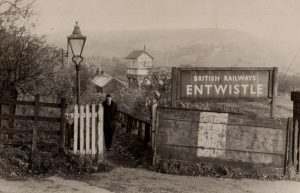 Entwistle and Wayoh, provided by the Lancashire and Yorkshire Railway to give extra capacity for freight trains. By the 60s there wasn’t much freight, apart from the evening Burnley – Moston on the up line and the Ancoats – Carlisle on the down.
Entwistle and Wayoh, provided by the Lancashire and Yorkshire Railway to give extra capacity for freight trains. By the 60s there wasn’t much freight, apart from the evening Burnley – Moston on the up line and the Ancoats – Carlisle on the down.
Paddy always welcomed a bit of company and the kettle was usually on the boil. I got off the diesel train and waved a cheerio to the Manchester guard, watching the train trundle away up the last bit of the climb towards Wayoh, the red tail light slowly disappearing from view on what was a fine, clear but bloody freezing night. You could see your breath almost freeze when you breathed out.
I jumped down off the platform and crossed the tracks to get to the signalbox steps. “Now then Paddy!” I shouted, so he wouldn’t think it was any unwanted visitor, such as an over-zealous inspector making an out of hours call.
I walked up the flight of stairs and found the door unlocked. The warmth from the stove hit you like a blanket as soon as you stepped in.
“Come in and sit yourself down lad,” said Paddy. “The kettle’s just boiled, here’s a nice cup of tea for ye.”
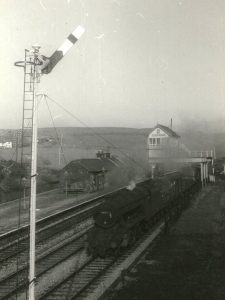
Like all the boxes in the area, there was an ‘easy chair’ that was the preserve of the resident signalman. There was usually another chair for visitors, not as comfortable but good enough. Decorum usually meant that the visitor would make do with the hard chair but Paddy was a true gent and offered me the easy chair.
“Thanks Paddy, that’s very kind. And here’s a card for you and the family.”
Paddy lived in one of the old railway cottages just beyond the pub, he and his family had been there for a good thirty years after moving from a box in the Manchester area, Collyhurst I think. He hailed from the west of Ireland and had no end of stories about life in ‘the ould country’. He loved the Lancashire moors and was the only applicant for the vacancy at Entwistle when the previous incumbent, Abraham Holroyd, retired.
“So Paul, are you and your young lady all ready for Christmas?” he asked.
“Oh, I think so. We’re going over to Sheila’s mother’s for Christmas Day but we’ll have a quiet time, see the rest of the family on Boxing Day, get out for a walk and take it easy.”
“Aye, it’s a time for family alright,” Paddy agreed. “They say it might be a white ‘un too, some snow forecast for tonight according to the news.”
“Well, it’s looking clear enough now,” I replied, not wanting to get snowed in at Wayoh Sidings for Christmas. “But anyway, I’d better be getting on, Frank will be wondering where I am.”
“Aye, he’s a stickler for punctuality is Frank, and no harm in that, for a signalman,” responded Paddy. “Be careful how you go and mind you don’t come across any of those Lancashire boggarts on the way!”
“I don’t think there’s any chance of that, Paddy, but if I do I’ve a spare copy of The Morning Star I can give them, to demonstrate they’re just an illusion!”
“On your way lad, and have a grand Christmas…just look out for the Burnley-Moston, not had it yet so it might be on its way.”
I left the cosiness of Paddy’s box and walked down the steps into the old goods yard and felt the first flurries of snow coming down. The clear bright sky had clouded over and there was an eerie light across the tracks.
If I walked briskly I’d be there in twenty minutes. The unfenced path ran alongside the up fast line and had been used by generations of railwaymen, and – unofficially – some of the local farmers and quarrymen too.
It started coming down heavily and within a couple of minutes I could hardly see the tracks, let alone the path. To make it worse, I was 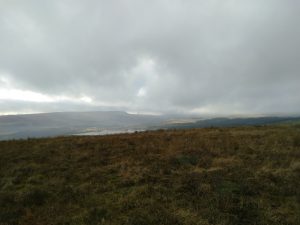 walking into the wind, howling down from Whittlestone Head and blowing the snow horizontally. I was struggling to see and the snow felt more like small balls of ice.
walking into the wind, howling down from Whittlestone Head and blowing the snow horizontally. I was struggling to see and the snow felt more like small balls of ice.
I was able to walk forward only by feeling the edge of the ballast to my left, under the rails of the up fast line.
I kept edging forward, stumbling a couple of times, and could just make out the lights of Wayoh Sidings box in the distance, through the blizzard.
Maybe I was getting over-confident; I was getting close when I went over. I hit a bit of redundant rail some dozy platelayer had left lying across the path. All I can recall is falling and striking my head against something hard. Then oblivion.
The next thing I can remember is a loud voice, shouting “come on lad, come on, tha’ cornt lie theer…look out!”
I came back into consciousness and felt a hand tugging at my feet. I became aware of the sound of a steam loco hard at work, and not far away.
It dawned on me that I was lying across the outer rail of the up fast, and the sound I could hear was the late-running Burnley – Moston goods, just passing Wayoh Sidings and a few yards from where I was lying. It was working hard, with the driver probably trying to make up a bit of lost time and get home to Manchester. Up here, he was a long way from Deansgate.
I felt another hard tug at my leg and the next instant the ‘whoosh’ of a heavy steam locomotive rushing by, at very close quarters. I could feel the leaking steam from the engine and the smell of hot oil. Then the clank of wagon after wagon as the train went past, followedby silence. I could also feel a small dog pulling at my trouser leg.
“Are you awreet lad?” a voice asked. “Tha’s just had a close call wi’ destiny!”
I looked up and through the snow, still coming down heavy. I could make out the shape of a large, bearded man in platelayer’s clothes.
“Tha must ha fallen onto th’ rail and knocked thisel eawt. Lucky aw were tekkin’ th’dog for a walk an’ saw thi. Let’s have a look at thi.”
I had a nasty bump on my head where I’d hit the rail and also felt as though I’d twisted my ankle when I went over.
“Con tha walk?” my rescuer asked.
“I’m not sure I can…but I have to relieve my mate in the box at 10.00.”
“Oh, he can wait a few minutes. Howd on to me an’ we’ll get you into my cabin just up th’line.”
We edged forward through the blizzard, both of us completely white, the snow biting into our faces like small sharp nails.
My rescuer pushed open the door of what looked like a platelayer’s cabin just set back from the track, I’d never seen it before. We entered a warm but dark room lit only by a blazing fire and an oil lamp on the table.
“Sit thiself on this chair,” he said. Let’s tek a look at thi. Wheer’s it hurtin’?
I explained about the bump to my head and what I thought was the sprained ankle from when I’d fallen.
“Let’s tek a look. Tha’s had a bit of bump awreet but it doesn’t look too bad. A sma’ cut but nowt much. We’ll soon fix that. Let’s have a look at that foot.”
He got on his knees in front of me and took hold of my injured left foot.
“Nowt to worry abeawt, but this meyt hurt for a minute lad.”
He got hold of my foot and gave it a good wrench. He was right, it was bloody painful.
“Ow! Bloody hell, what’re you doin’?” I asked.
“Don’t fratch, it’ll be awreet, tha’ll see. Now let’s get that head wound dressed.”
A bandage appeared from what looked like a battered old first aid box and he cut a couple of pieces, laying them on the table. He dabbed some sort of lotion on the bruise, had an odd smell that I can’t describe but quite pungent, then wrapped the bandage around my head, securing it with a knot.
“Tha’s had a nasty bang on th’yed, but tha’ll live. Aw’ve dabbed a bit o’comfrey on that bruise, it’ll heal it gradely weel in a day or two. Grew it in mi own garden. Let’s get thi up to th’box, tha should be fit for duty neaw.”
We went out into the cold night air to find the blizzard had stopped. The clouds had rolled away leaving a clear, starry night with the path up to the box illuminated by a full moon. About six inches of snow had fallen.
We walked in silence up towards the box, the lights getting closer and stronger as we trudged through the undisturbed snow. I held on to my rescuer and hopped along on one foot, not putting pressure on the injured one. The little dog ran by his side.
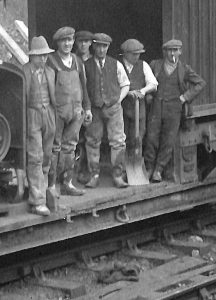 We got to the steps leading up to the box and I turned to wish my rescuer a hearty thanks, with an invitation to come up for a brew. I hadn’t even had chance to ask his name.
We got to the steps leading up to the box and I turned to wish my rescuer a hearty thanks, with an invitation to come up for a brew. I hadn’t even had chance to ask his name.
“Aw’ll tek me leave neaw, th’wife’s expectin’ me back. Aw think tha’ll find that yon foot is healed and just give that bruise on thi yead a couple o’days.”
I turned round and there was no sign of him.
But what was most strange was that there were no footprints leading away from the signalbox. Maybe the wind had blown some drifts across the path.
Before I had time to think any further, the signalbox door opened and Frank shouted down to me. “Are you alright Paul? Paddy had told me you were on your way and then that friggin’ blizzard came on. Worried you’d got caught out by that freight.”
“Well I’ve had a strange experience, that’s for sure. Is that kettle on?”
I entered the signalbox; inside it was pretty much the same as Entwistle, a standard L&Y design. The fire was blazing away merrily.
“What’s happened to thi lad? What’s the bandage for?” Frank asked.
I explained to him that I’d tripped on some lineside junk and fallen onto the track, knocking myself out. Someone had pulled me away just in time before the freight passed. Whoever it was, he’d saved my life. And on top of that he’d dressed my wound and my foot was no longer in pain. I realised I could walk on it as normal.
“Sounds like tha’s seen a boggart!” said Frank, a man well versed in Lancashire folklore and daft tales.
“Somebody helped me, that’s for sure. I owe my life to him, but I’ve not a clue who the bloody hell he was – and he just disappeared. A bit of blowing snow probably covered up his footprints but I’ve no idea where he went. He said he was out taking his dog for a walk.”
I described his appearance, as much as I could, to my colleague. Tall and thick set, beard. Wearing what looked like old-fashioned working clothes, railway greatcoat, smelling of tobacco. Spoke broad Lancashire.
“Did he look like that chap, on the photograph over the frame?” Frank pointed to an old black and white photograph amongst a group of pictures of the line and the box, taken in the early 1900s by the look of them. Sure enough, one of the men in a group of platelayers was a spitting image, as much as I could see, of my rescuer. Even his clothes looked the same, with the cap and heavy overcoat. And there was the little dog by his side.
“That’s Bill Horrocks, he was foreman platelayer when there was still a small gang up here. Before the First World War. Bill was prominent in the railway first aid movement – chairman of the Bolton branch. He used to go round giving lectures on railway safety and first aid, won lots of prizes so they say. Swore by herbs, his house was full of all sorts of different lotions and potions. It’s ironic that he was killed in a railway accident, trying to rescue a workmate who’d fallen onto the rails, just down the line from here. He got his injured mate out of the way but didn’t have time to get out of the road himself. His little dog tried to pull him out of the way, so they say, but he was too heavy. Killed outright. They laid out his body in the old platelayer’s cabin just down the line – it’s derelict now, roof’s gone, but you can still see it from the line, if you look carefully. Anyway lad, I’ve arranged with the driver of the Newton Heath empties to give me a lift home and he’s just passed Spring Vale, so I’d better get down to meet him. Merry Christmas, and have an easy shift. Don’t see any more ghosts!”
Frank picked up his bag and disappeared down the steps. I saw the train’s lights as it emerged from Whittlestone Tunnel, slowing down to pick him up. A friendly toot on the horn and the train disappeared into the distance. I replaced my signals to danger and settled down to a quiet night, under the protective gaze of Bill Horrocks.
The Wisdom of Solomon
Solomon Partington is a name that probably doesn’t mean a lot to most Salvo readers. It may ring a bell with those of you who’ve followed the story of the Winter Hill Mass Trespass of 1896, whose 125th anniversary was celebrated last September. Yet the North owes a lot to him, not least for his campaigning for public rights of way but also for promoting local democracy. Partington was the quintessential Lancastrian, a champion of Lancashire cultural identity.
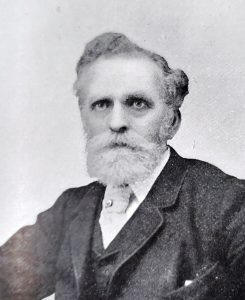
Bolton writer Allen Clarke described him in his Moorlands and Memories (1920) in gushing terms: ‘as great a champion of liberty and justice as ever used a pen on behalf of the robbed and oppressed’. He was one of the key figures in the Winter Hill ‘Trespass’ of 1896, an event celebrated by hundreds of Boltonians last September. But there’s a lot more to this extraordinary man than that single event, important though it was.
He was born in Alkrington, Middleton, in 1844. At the time, it was an expanding cotton town, famous for being the home of the hero of Peterloo, Samuel Bamford. Handloom weaving was still a common occupation and Middleton was noted as centre of silk weaving. Both Partington’s parents were silk weavers, part of a highly cultured and well-read industrial community which was, by then, beginning to disappear. In 1866 he married Eliza who was the daughter of a silk weaver, Adam Butterworth.
The young Solomon got a job on the railways as a clerk, then quite a highly regarded position for a working class lad. In 1871, at the young age of 26, he was promoted to station master at Birkdale, near Southport. The family moved from Middleton, probably occupying a railway house provided by the Lancashire and Yorkshire Railway.
However, following unfounded accusations of embezzlement, he resigned from the company and got a job as a reporter on the Leigh Journal in 1874. The paper was part of the Tillotson group of publishers whose titles included the Bolton Evening News and Bolton Journal and Guardian.
Partington became involved in local politics as a member of the Liberal party. He had already become active in the co-operative movement in Middleton, and subsequently wrote a history of the society, published in 1900; his commitment to co-operative principles stayed with him all his life. During his time in Leigh, Partington was involved in campaigns for better children’s facilities. In February 1885 he reported in the Leigh Journal on a meeting held at the Co-op Reading Room with influential businessmen and community leaders, to discuss their concerns about Leigh’s children having nowhere to play. The issue was taken up by the local council of the day, Leigh Local Board. They met to discuss the issue in August that year and Partington decided to exert public pressure. Whilst the councillors deliberated in the Town Hall, Solomon Partington led a ‘Thousand Lads of Leigh’ march past the building, with hundreds of lads carrying bats and balls shouting ‘we want a playground’. Amongst their number was Joseph Ashworth, then aged 14 and a little piecer in a local mill. Although the council decided it couldn’t afford a public park, Partington’s campaign finally succeeded. Ashworth stood for council and eventually became mayor; after a wait of nearly thirty years Leigh got its children’s play facilities.
The ‘Thousand Lads of Leigh’ march was an important and largely forgotten event: a rare example of children becoming involved in a local campaign. As a result of Partington’s efforts he became celebrated as ‘The Children’s Friend’ and was presented with a testimonial when he left Leigh in 1887 to work for The Bolton Evening News. He wrote for several Tillotson publications and developed a speciality in local history, using the by-line of ‘Historicus’,
For a while, Partington remained an active member of the Liberal Party, supporting Gladstone’s ‘home rule for Ireland’ campaign. He became increasingly concerned about public rights of way and the growing number of footpaths, walked for generations without obstruction, being closed by landowners. The event which acted as the catalyst for Britain’s biggest-ever rights of way battle was Colonel Richard Ainsworth’s action in closing Coal Pit Road, from Smithills up to Winter Hill, in the summer of 1896. Partington made common 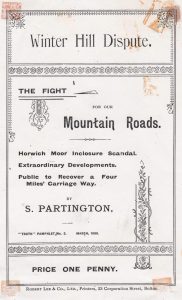 cause with local socialists such as Joseph Shufflebotham in organising opposition to Ainsworth’s footpath closure, and a demonstration was organised for Sunday September 6th 1896, with announcements in the Bolton Journal and Guardian and other local papers that it would set off at 10.00 from the Bottom of Halliwell Road, ‘to test the right of way’. A few hundred gathered at the start of the march, but by the time it reached The Ainsworth Arms, at the top of Halliwell Road, the ranks had swelled to about 10,000. There was a melee at the point where Ainsworth ahd erected a gate to deter walkers, and the gate was unceremoniously destroyed. Further demonstrations followed, with the following Sunday’s being the biggest, with an estimated 12,000 taking part. Partington’s experience with the ‘Thousand Lads’ march in Leigh, over ten years previously, was clearly being put to good effect.
cause with local socialists such as Joseph Shufflebotham in organising opposition to Ainsworth’s footpath closure, and a demonstration was organised for Sunday September 6th 1896, with announcements in the Bolton Journal and Guardian and other local papers that it would set off at 10.00 from the Bottom of Halliwell Road, ‘to test the right of way’. A few hundred gathered at the start of the march, but by the time it reached The Ainsworth Arms, at the top of Halliwell Road, the ranks had swelled to about 10,000. There was a melee at the point where Ainsworth ahd erected a gate to deter walkers, and the gate was unceremoniously destroyed. Further demonstrations followed, with the following Sunday’s being the biggest, with an estimated 12,000 taking part. Partington’s experience with the ‘Thousand Lads’ march in Leigh, over ten years previously, was clearly being put to good effect.
Ainsworth took a number of the organisers, Partington being one of the most prominent, to court. The case was heard at Lancashire Chancery Court, in Manchester, during march 1897. Despite having the support of many local townspeople, and ably represented by Richard Pankhust, husband of the famous suffrage leader Emily, the case went against them. Although nobody was sent to prison, costs 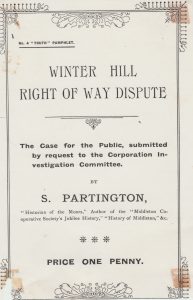 totalling £565 were awarded against the protestors and Partington and his friend (and treasurer of the Defence Committee) William Hutchinson found themselves saddled with having to find £600. His erstwhile socialist friends appeared to have abandoned them. Partington mounted an energetic campaign to recover some of the costs; the most generous supporter was William Hesketh Lever (Later Lord Levehulme) who contributed £100. A further £165 was given by local people including the Liberal M.P. George Harwood.
totalling £565 were awarded against the protestors and Partington and his friend (and treasurer of the Defence Committee) William Hutchinson found themselves saddled with having to find £600. His erstwhile socialist friends appeared to have abandoned them. Partington mounted an energetic campaign to recover some of the costs; the most generous supporter was William Hesketh Lever (Later Lord Levehulme) who contributed £100. A further £165 was given by local people including the Liberal M.P. George Harwood.
Between 1899 and 1901 he produced a series of six ‘Truth’ pamphlets arguing the case for public rights of way, using ancient records. In 1904 he was elected on to Bolton Council, running on an independent ‘public rights’ platform supported by Clarke and his Northern Weekly. It 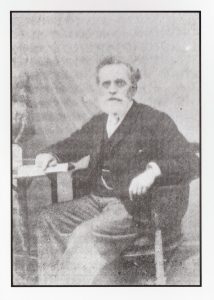 seems he became frustrated with the lack of support for his campaigns within the local Liberal Party and became more aligned to the local Labour Party. His election agent was Allen Clarke who used the pages of his Teddy Ashton’s Northern Weekly to win support for Partington.
seems he became frustrated with the lack of support for his campaigns within the local Liberal Party and became more aligned to the local Labour Party. His election agent was Allen Clarke who used the pages of his Teddy Ashton’s Northern Weekly to win support for Partington.
After his victory, Clarke wrote: “We addressed outdoor meetings at the gates of the big iron works, and other places; also on the Town Hall Square. Dozens of Northern Weekly readers also worked quietly for us, in their own streets – and all of these, known or unknown to us, have a share in the great victory.”
He served the people of West Ward (Halliwell and Smithills) until 1911, with a year’s break in 1907. He was a key figure in the Bolton Municipal Reform League, together with his socialist friend Sarah Reddish, with whom he shared a common passion for the principles and practice of co-operation. His history of Middleton and Tonge Co-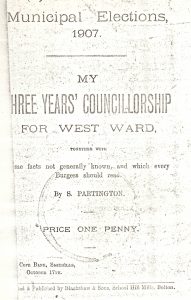 operative Society was published in 1920. Partington remained in touch with public rights of way campaigners in Bolton and wrote an extended letter to Bolton Housing and Town Planning Committee in 1915, highlighting unresolved footpath issues.
operative Society was published in 1920. Partington remained in touch with public rights of way campaigners in Bolton and wrote an extended letter to Bolton Housing and Town Planning Committee in 1915, highlighting unresolved footpath issues.
Partington shared Allen Clarke’s love of the Lancashire dialect and was a member of the Lancashire Authors’ Association which Clarke set up in 1909. After his move to Silverdale, and then Grange-over-Sands, Partington devoted himself to historical research though he never completed his intended ‘magnum opus’ – a history of Lancashire dialect writing. His two books on the dialect, The Future of Old English Words and Romance of the Dialect, show what might have been achieved.
He died on August 5th 1927 and the obituary in The Bolton Evening News paid tribute to “a trenchant and fearless writer who used the Press in full measure, though never unfairly, for the advance of schemes for the public good.” He is buried in Grange-over-Sands.
(first published in the Bolton News)
Harrogate’s Railways
Martin Bairstow has just brought out a new and enlarged edition of Railways Through Harrogate. It’s a must if you live in Harrogate or like trains…or for that matter, if you are interested in that fascinating part of Yorkshire that embraces York, Knaresborough, Harrogate, the Nidd Valley, Otley, Wetherby and the north of Leeds.Martin combinesd a good understanding of railway history with a real feel for the places that the railway served. What a travesty that trains no longer go to Wetherby or Otley! Martin is acerbic in his criticism of the decision to 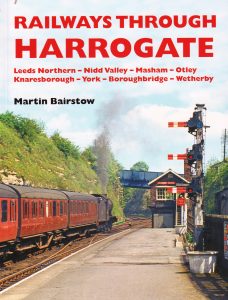 close lines which, had they survived, would have been thriving and part of the electrified network, for certain. There is a fascinating chapter on accidents and the railways’ sometimes reluctant efforts to make their operations safer. The chapter titled ‘Lock, Block and Brake’ pus railway safety in a wider political context, making use of Bairstow’s encyclopedic parliamentary knowledge. There’s an interesting section on the Poppleton Community Railway Nursery, just outside York. I was about to say that there can’t be many garden centres with their own railway but actually there’s quite a few. Poppleton’s claim to fame is that it was an original railway nursery, created by the LNER during the Second World War, and was the very last. I gave a helping hand in rescuing the nursery in my Northern Rail days and it now thrives as a community project.
close lines which, had they survived, would have been thriving and part of the electrified network, for certain. There is a fascinating chapter on accidents and the railways’ sometimes reluctant efforts to make their operations safer. The chapter titled ‘Lock, Block and Brake’ pus railway safety in a wider political context, making use of Bairstow’s encyclopedic parliamentary knowledge. There’s an interesting section on the Poppleton Community Railway Nursery, just outside York. I was about to say that there can’t be many garden centres with their own railway but actually there’s quite a few. Poppleton’s claim to fame is that it was an original railway nursery, created by the LNER during the Second World War, and was the very last. I gave a helping hand in rescuing the nursery in my Northern Rail days and it now thrives as a community project.
Railways Through Harrogate is priced at £17.95 and should be in everyone’s Christmas stocking.
Fellowship is Life!
It’s very heartening to see Denis Pye’s superb book on the Clarion Cycling Club appear in a new edition. Denis was a great friend and a much-loved part of the Lancashire libertarian socialist scene. He played a major role in keeping the Bolton Socialist Club going when the outlook was very bleak. The new edition has a lovely foreword by his widow, Wendy, The book has a new introduction which brings the story of the remarkable Clarion up to date. It was formed as the cycling auxiliary of the Clarion newspaper, edited by Robert Blatchford, in the years before the First World War, which in many ways were the socialist movement’s years of innocence. The Clarion Cycling Club was formed in 1894 and put down deep roots in the North of England, enjoying 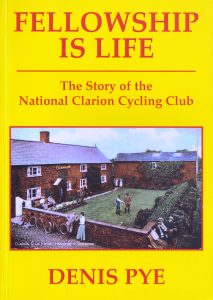 close links with the Independent Labour Party and a plethora of local socialist organizations. In parts of Lancashire and Yorkshire members created ‘Clarion club houses’ which acted as workers’ holiday resorts – you could call in for lunch during a ride, or you could stay for a few weeks and enjoy a game of tennis, read uplifting books and argue socialism, anarchism and liberalism with fellow guests. One survives, the Clarion House at Roughlee, near Nelson. It was visited by Michael Portillo in his ‘Great Railway Journeys’ and in true Lancashire socialist style he was given a warm, friendly welcome.
close links with the Independent Labour Party and a plethora of local socialist organizations. In parts of Lancashire and Yorkshire members created ‘Clarion club houses’ which acted as workers’ holiday resorts – you could call in for lunch during a ride, or you could stay for a few weeks and enjoy a game of tennis, read uplifting books and argue socialism, anarchism and liberalism with fellow guests. One survives, the Clarion House at Roughlee, near Nelson. It was visited by Michael Portillo in his ‘Great Railway Journeys’ and in true Lancashire socialist style he was given a warm, friendly welcome.
This is a lovely book and can be heartily recommended. Fellowship is Life: The Story of the National Clarion Cycling Club, by Denis Pye is published by National Clarion 1895 Publishing and costs £10. It is available on Amazon but why not take a ride or walk to Clarion House (only open Sundays) and get a copy from them?
Lancastrians: at a gradely book shop near you soon
Lancastrians: Mills, Mines and Minarets is being published next year by the highly-respected publishers Hurst whose catalogue is well worth a look at it. See https://www.hurstpublishers.com/catalogues/spring-summer-2023/. The page on Lancastrians says: “This long-overdue popular history explores the cultural heritage and identity of Lancashire. Paul Salveson traces to the thirteenth century the origins of a distinct county stretching from the Mersey to the Lake District—‘Lancashire North of the Sands’. From a relatively backward place in terms of industry and learning, Lancashire would become the powerhouse of the Industrial Revolution: the creation of a self-confident bourgeoisie drove economic growth, and industrialists had a strong commitment to the arts, endowing galleries and museums and producing a diverse culture encompassing science, technology, music 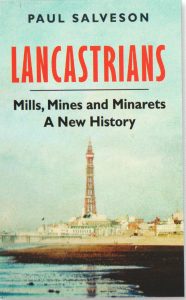 and literature. Lancashire developed a distinct business culture, its shrine being the Manchester Cotton Exchange, but this was also the birthplace of the world co-operative movement, and the heart of campaigns for democracy including Chartism and women’s suffrage. Lancashire has generally welcomed incomers, who have long helped to inform its distinctive identity: fourteenth-century Flemish weavers; nineteenth-century Irish immigrants and Jewish refugees; and, more recently, New Lancastrians from Asia, Africa and Eastern Europe. The book explores what has become of Lancastrian culture, following modern upheavals and Lancashire’s fragmentation compared with its old rival Yorkshire. What is the future for the 6 million people of this rich historic region?”
and literature. Lancashire developed a distinct business culture, its shrine being the Manchester Cotton Exchange, but this was also the birthplace of the world co-operative movement, and the heart of campaigns for democracy including Chartism and women’s suffrage. Lancashire has generally welcomed incomers, who have long helped to inform its distinctive identity: fourteenth-century Flemish weavers; nineteenth-century Irish immigrants and Jewish refugees; and, more recently, New Lancastrians from Asia, Africa and Eastern Europe. The book explores what has become of Lancastrian culture, following modern upheavals and Lancashire’s fragmentation compared with its old rival Yorkshire. What is the future for the 6 million people of this rich historic region?”
The book will be published in June 2023 in hardback, price £25.
Last Train from Blackstock Junction
My new book comprising 12 short stories about railway life in the North is now available. Last Train from Blackstock Junction includes a very appropriate tale about the last train from somewhere called ‘Blackstock Junction’ on November 5th 1966, when a group of kids succeeded in stopping the Glasgow – Manchester express which they mistakenly thought was the last stopping train from their local station. Oops.What very naughty boys. Don’t try this on your local railway.
The book has a very kind foreword by Sir Peter Hendy, chairman of Network Rail, who said “As you read these stories, you’ll find some history, some romance, some politics, a little prejudice – sadly – and some humour; you will in fact be in the world of railway men and women. I hope you find them as absorbing as I did when I read Paul’s manuscript. Please enjoy his work!”
Writer and environmentalist Colin Speakman said “it is an amazing collection – powerful, moving, and what I would call ‘faction’ which tells truths even though the details may be fantasy, ‘Hillary Mantel school of history’ perhaps. Director of Platform 5 Publishing, Andrew Dyson, said “Paul’s stories provide a fascinating insight into what life
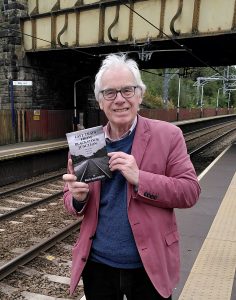
was really like for thousands of railway workers.”
The tales also include a ghost story set in a lonely signalbox in Bolton, in 1900 (‘Who Signed The Book?’) while other stories are about life on today’s railway, including ‘From Marxist to Managing Director’ – the story of a young female political activist who ends up running a train company. Some are set in the ‘age of steam’ and life on the footplate as well as the rise of the trades unions on the railways and the rise of the Labour movement.
Salvo readers will get the book at a specially discounted price, courtesy of Platform 5 Publishing. Go to https://www.platform5.com/Catalogue/New-Titles. Enter LAST22 in the promotional code box at the basket and this will reduce the unit price from £12.95 to £10.95.
Talks, walks and wanderings
Following the ‘official’ end of the Pandemic, I’ve been getting a number of invitations to give talks on various topics. Recent talks have included ‘The Social History of Lancashire’s Railways’ for Preston Historical Society, ‘Allen Clarke’s Bolton’ for Friends of Smithills Hall and Bolton U3A, ‘Railways and Railwaymen of Turton’ for Turton LHS, ‘Moorlands, Memories and Reflections’ for What’s Your Story, Chorley? and ‘Railways and Communities: Blackrod and Horwich’, for Blackrod LHS. Next Tuesday evening I’m talking to Chorley Archaeological Society on ‘The Lost Railways of Lancashire’. I’m speaking on ‘Railways in the North’ for the Stephenson Locomotive Society in Manchester on November 5th. The following Saturday I’m at Shap Wells talking to the Cumbrian Railway Association on the Settle-Carlisle Railway. Other topics are:
- The Lancashire Dialect Writing tradition
- The Railways of the North: yesterday, today and tomorrow
- Allen Clarke (1863-1935) Lancashire’s Romantic Radical
- The Winter Hill Mass Trespass of 1896
- The Rise of Socialism and Co-operation in the North
- The Clarion Cycling Clubs and their Club Houses
- Walt Whitman and his Lancashire Friends
- Forgotten Railways of Lancashire
- Banishing Beeching: The Community Rail Movement
- Railways, Railwaymen and Literature
I charge fees that are affordable to the organisation concerned, to fit their budget – so by negotiation. My preferred geographical location is within 25 miles of Bolton, ideally by train/bus or bike. With sufficient notice I can go further afield.
READERS’ LETTERS: HS2, Ian Jack, trains to Heywood (lack of)
Malcolm Bulpitt says: “Thank you for your good critique on HS2. A long time ago many transport professionals, whose living did not come from the project, were pointing out that in reality it was nothing more than London’s Crossrail 3. All it will really serve is to enable a lot of homes to be built on land that is cheaper than in the SE, and give their purchasers a swift commute into London, and their households access to the Capital’s multitude of commercial, cultural and retail facilities. Basically it is being built to enable Metroland to be reborn 100 years on. This political vanity project has inevitably become a financial black hole that Mr Hunt would be wise to kill off ASAP. That action alone would probably balance the nation’s budgetary woes.”
David Spaven writes : “That was a most fitting tribute to Ian Jack, one of the finest journalists Scotland (and Bolton – ed.) has ever produced. His spirit of enquiry, and fascination with the details of everyday life – and how they connected with the bigger picture – have perhaps only been emulated in modern times by one other Scotsman, the late Kenneth Roy. Not as well known as he should have been, Roy – who memorably and movingly described the approach of his death in ‘In Case of Any News: Diary of Living and Dying’ – uses rural railways as a metaphor to explore the very point of our existence: ‘Branch lines matter. They have all gone as physical artefacts – grassed over and eroded by rain and gravity as completely as any Roman road or earthworks. But they can still exist in our imagination. The main line proceeds at speed to a predictable and deadly terminus. On a main line, the light at the end of the tunnel is that of the incoming train. Choose instead the gentle and meandering branch line of unorthodox thought and feeling.”
Richard Stewart Greenwood says: corrects John Davies on Bury – Rochdale closure: “The rail service to Heywood was not removed as a result of Beeching. Beeching’s plan was for the Rochdale-Heywoodf-Bury-Bolton-Wigan line to be retained. Closure of Heywood station and the line Castleton to Bolton did not happen until December 1966.
Why does no-one criticize the lack of through running on Preston to Liverpool and Wigan Wallgate to Liverpool?
John replies: “Thanks, Richard Greenwood, for your correction. I have accused others over time of attributing every 60’s closure to Beeching so ‘mea culpa’! It would be interesting to know why Rochdale to Bolton was closed if Beeching had suggested retention. For good measure, why was Bury to Accrington closed; and something that puzzled me when I worked in Yorkshire for a short time in mid/late’60’s, why lines such as the Spen Valley (heavily populated with an interval dmu service) closed? One thing I remember was a Yorkshire Post headline in 1967 announcing the impending closure of the Settle and Carlisle line on a nominated date in 1970; and look what that started!”
Jim Trotmansays of Salvo 308: “Thanks Paul – many good points about HS2 and the preoccupation with very high speed. Thanks too for the mention of Oxenholme – Windermere. I fear that has been stalled as it is not in a Tory constituency. I’m also sure that there was no intention by Truss to put any time or money into implementing HS3 – just a headline followed by future condemnation of another government for not doing it.
New Projects
Lancastrians has kept me busy for most of the year and will be published by Hurst (who recently brought out the fascinating Northumbrians) next year. See above. I’m contemplating writing ‘a people’s history of Farnworth’, using the structure of Lancastrians (work, play, politics, culture, sport, individual profiles etc.).
Still in Print (at special prices!)
ALLEN CLARKE: Lancashire’s Romantic Radical £6.99 (normally £18.99)
Moorlands, Memories and Reflections £15.00 (£21.00)
The Works (novel set in Horwich Loco Works) £6 (£12.99)
With Walt Whitman in Bolton £6 (£9.99)
The Settle-Carlisle Railway (published by Crowood £24) – can do it for Salvo readers at £12
See www.lancashireloominary.co.uk for full details of the books (ignore the prices shown and use the above – add total of £4 per order for post and packing in UK)
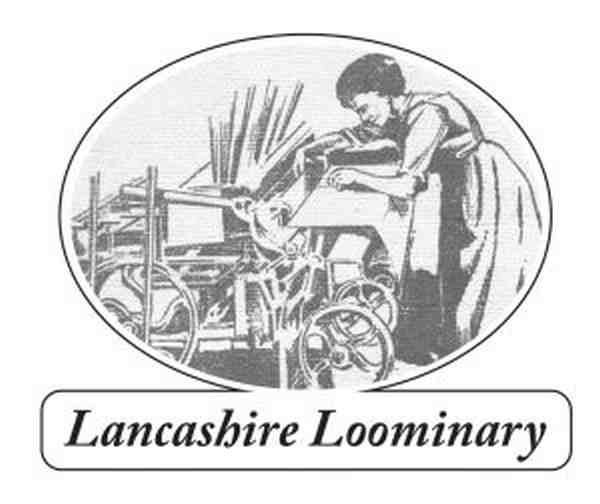
4 replies on “Northern Weekly Salvo 309”
Many thanks. Good also to read of Martin’s new book! Liked the story….. Cheers and a good Xmas! Walter
Thanks for including a review of Denis’s book, Paul.
Thanks for the story about the boggart, Paul and Happy Christmas from snowy Canada.
Jim
The Bolton-Rochdale passenger service lasted until 1970, and was thus one of the last post-Beeching closures.